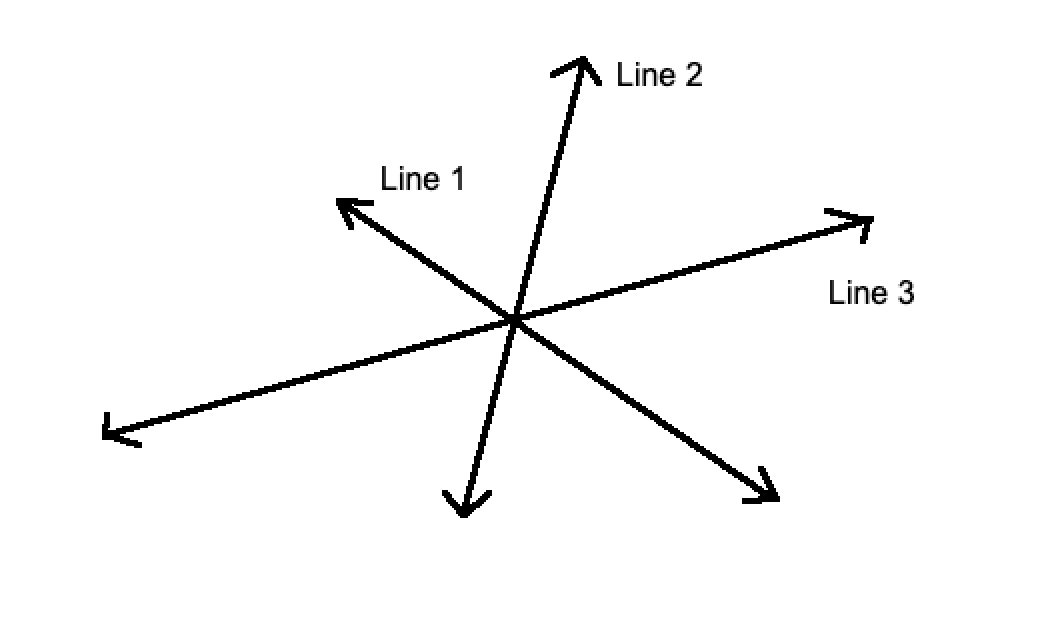How to find Intersecting Lines?
Last Updated :
23 Jan, 2023
Geometry is the branch of mathematics dealing with points, lines, angles, and figures. In other words, geometry is the study of figures, and the quantities related to them such as their measurements and dimensions. Figures and angles are composed of lines, which in turn are composed of numerous points. In Geometry, the straight lines can be broadly categorized into Intersecting Lines and Parallel Lines
Intersecting lines
Lines that cross one another i.e lines that have a meeting point in common between them are called intersecting lines, here the common point of the intersecting lines is known as the point of intersection. Or we can say that when two or more lines that are coplanar to each other and meet at a common points the such types of lines are known as intersecting lines. An important point to note here is that intersecting lines meet at only one point, if the lines meet at more than one point they don’t qualify to be called intersecting lines and instead fall in the category of curved lines.

Characteristics of Intersecting Lines:
- Intersecting Lines cross/meet at exactly one point.
- Intersecting Lines can cross one other at any possible angle between zero to one-eighty degrees.
- When two lines intersect, a pair of vertically opposite angles are formed at the intersecting point.
Perpendicular Lines are a special types of intersecting lines that form an angle of 90 degrees on their meeting point. Here, the two lines: Line1 and Line2 meet at ninety degrees.

How do you find intersecting lines?
Solution:
Let us considered two lines p1 and p2 and now we find the point of intersection.
The equation of lines are
a1x + b1y + c1 = 0
a2x + b2y + c2 = 0
Now let us assume that the point of intersection is (x0, y0)
So,
a1x0 + b1y0 + c1 = 0
a2x0 + b2y0 + c2 = 0
Using the Cramer’s rule we get,
x0/(b1c2 – b2c1) = -y0/(a1c2 – a2c1) = 1/(a1b2 – a2b1)
Hence the point of intersection is
(x0, y0) = (b1c2 – b2c1/a1b2 – aq2b1, c1a2 – c2a1/a1b2 – a2b1)
So this is how we can find the intersecting lines
Angle of Intersection
Now we find the angle of intersection. So, the equation of the two lines in the slope intercept form are:
y = (-a1/b1)x + (c1/b1) = m1x + C1
y = (-a2/b2)x + (c2/b2) = m2x + C2
So,
tan θ = tan(θ2 – θ1) = tanθ2 – tanθ1/1 + tanθ1tanθ2 = m2 – m1/1 + m1m2
Example:
Given lines: y = 4x + 8 and y = 3x + 9
At the point of intersection both the lines have same point of intersection so
4x + 8 = 3x + 9
4x -3x = 9 – 8
x = 1
Now put the value of x in any of the above equation we get
y = 4 + 8
y = 12
So the intersection point is (1, 12)
Sample Questions
Question 1. Two lines meet at two points. Can they be called intersecting lines?
Solution:
No, the lines can’t be called intersecting lines as they don’t follow the criteria of intersecting lines of meeting at exactly one point.
Question 2. Depict diagrammatically the intersection of two lines.
Solution:
Intersecting lines can be depicted as follows:

Question 3. Given two lines when extended infinitely always have the same distance and don’t have even a single point in common. Do such lines qualify to be called intersecting lines?
Solution:
No, such lines don’t satisfy the criteria of intersecting lines, instead of above all are the characteristics of parallel lines. So, we can call the above lines parallel instead of intersecting lines.
Question 4. Given two lines intersect at 90 degrees. What will such a pair of intersecting lines be called?
Solution:

The given pair of intersecting lines would be called Perpendicular Lines.
Like Article
Suggest improvement
Share your thoughts in the comments
Please Login to comment...